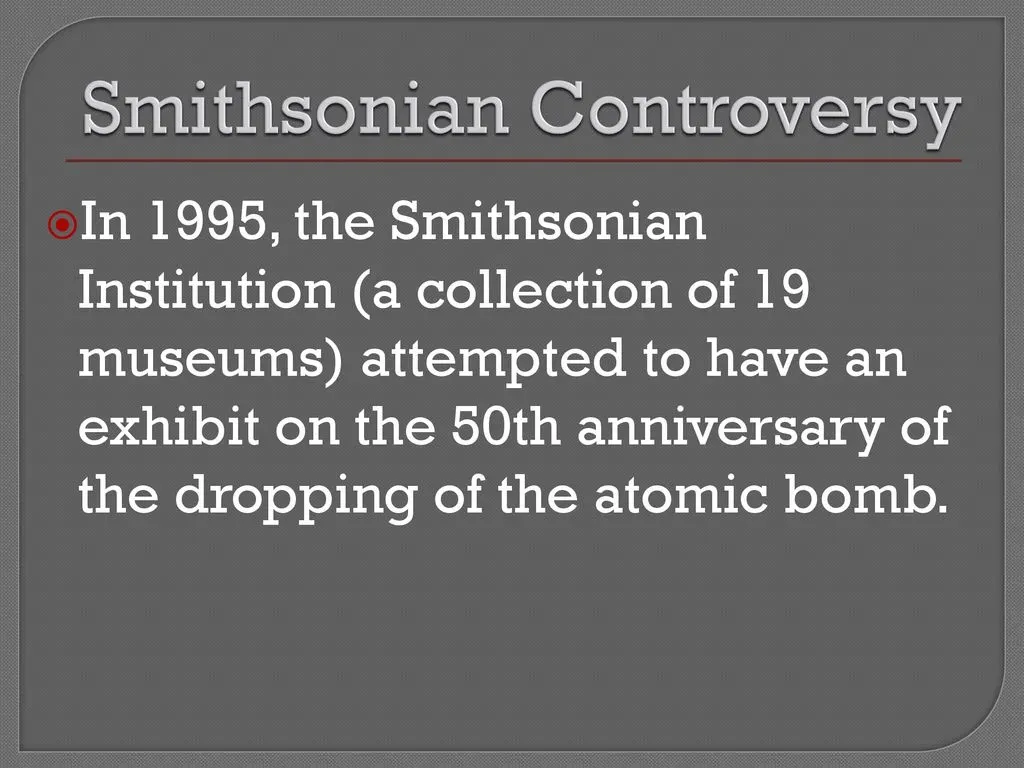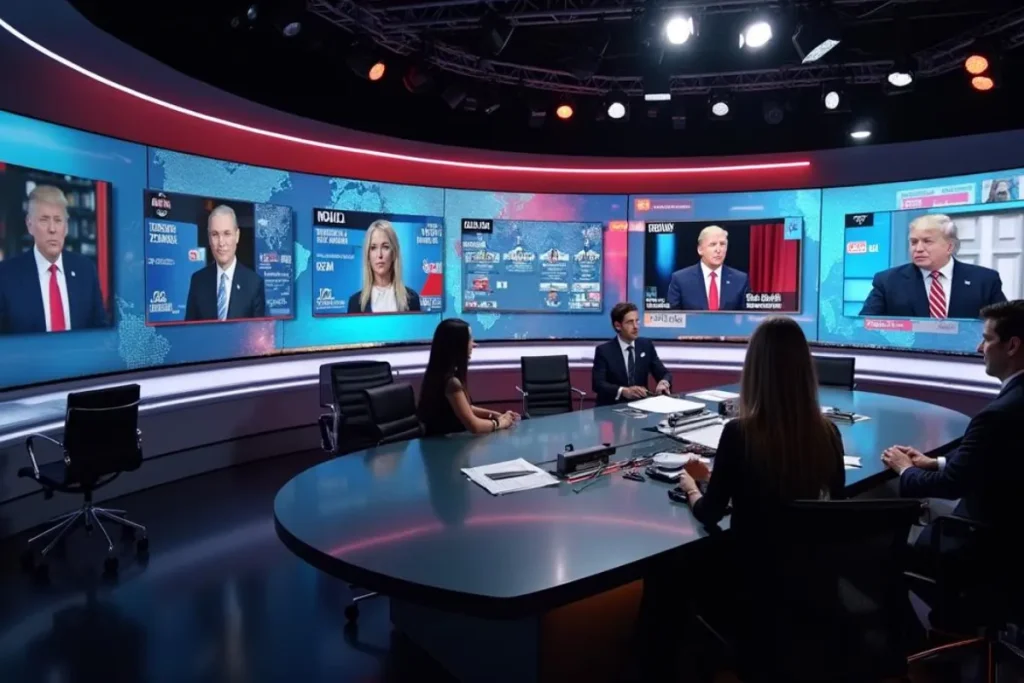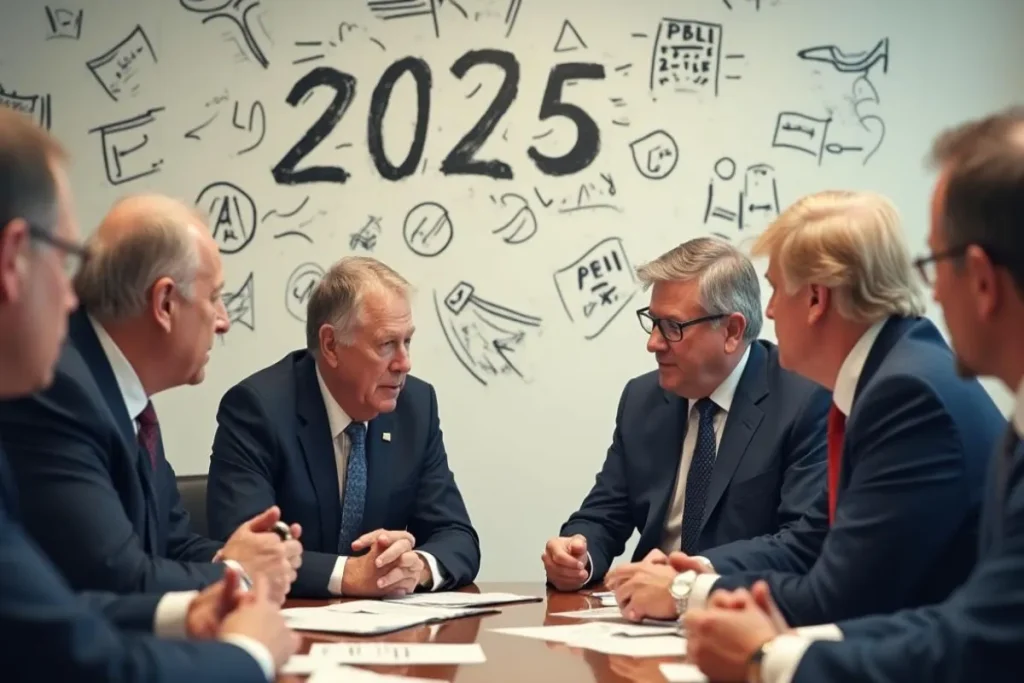The Smithsonian Institution controversy has sharply divided opinions as the Trump administration critiques the nation’s prominent museum complex for allegedly promoting “one-sided, divisive political narratives”. According to a White House official, the National Museum of American History’s recent Entertainment Nation exhibit exemplifies this issue by presenting American pop culture through a politically charged lens that some view as biased. Accusations suggest that federal funds are being misused in a manner that undermines the very ideals that America stands for. Officials argue that the museum must present a balanced view of history that aligns with the greatness of the American narrative, rather than framing it through a lens of violence or imperialism. As this issue circulates in public discourse, it raises broader questions regarding the role of cultural institutions in shaping America’s historical and political narratives.
The ongoing debate surrounding the Smithsonian Institution reflects a larger struggle over the portrayal of American history within cultural frameworks. Amidst rising tensions, the Trump administration has targeted the taxpayer-supported museum complex for allegedly advancing a politically charged agenda that resonates poorly with many Americans. This situation illustrates a conflict over narratives presented in exhibitions like the National Museum of American History’s Entertainment Nation, where questions about historical accuracy and representation have gained prominence. As stakeholders express concerns about content that appears to challenge traditional values, the need for a thorough reassessment of institutional roles in American storytelling has emerged. Such contentions highlight an ongoing discourse about how major cultural institutions should navigate their responsibilities in depicting the essence of American identity.
The Smithsonian Institution Controversy: A Political Divide
The current controversy surrounding the Smithsonian Institution has heightened discussions about how cultural narratives are presented in American museums. The Trump administration has accused the Smithsonian of promoting “one-sided, divisive political narratives” that favor a progressive interpretation of American history. Criticism is particularly leveled at exhibits like the National Museum of American History’s Entertainment Nation, where artifacts and interpretations have been described as politically charged. By examining items through a lens that some consider revisionist, the narrative of American greatness is called into question, sparking debate over whether federal funds should support these representations.
Widening the lens on the Smithsonian controversy reveals a larger political landscape where cultural institutions become battlegrounds for ideological warfare. The White House’s involvement indicates significant concern over the portrayal of historical and cultural milestones, suggesting that these institutions should not veer into ideological advocacy. With stakeholders championing a more balanced portrayal of American achievements, the ongoing scrutiny of the Smithsonian’s exhibits reflects tensions within American society regarding identity, history, and the impact of narratives woven into the fabric of cultural institutions.
Critics argue that the way history is being framed in exhibits like Entertainment Nation reflects broader societal issues. The controversy highlights the responsibility museums have not only as educators but also as custodians of a collective American identity. Amid the Trump administration’s recent directives, there is an urgent call for museums to promote narratives that affirm a cohesive American story, avoiding the divisive frameworks seen in recent installations. Such expectations pose significant questions about the role of cultural institutions in an increasingly polarized political environment.
Additionally, the financial implications of this review process stir the debate on how taxpayer dollars should support museums that may engage in politically-charged storytelling. With a significant portion of the Smithsonian’s funding coming from federal appropriations, it is vital for these institutions to garner public trust and ensure their narratives resonate with the values most Americans hold dear. This ongoing examination ultimately probes the fundamental purpose and integrity of museums in serving the audience they represent.
Entertainment Nation Exhibit: A Closer Look
The National Museum of American History’s Entertainment Nation exhibit has ignited considerable controversy due to its politically inflected interpretations of American pop culture. Several panels within the exhibit present a critique of iconic American figures, framing them within narratives that some argue misrepresent American values. For instance, the portrayal of The Lone Ranger and Mickey Mouse has been examined through nuanced, often critical lenses that align with contemporary social issues rather than traditional celebratory narratives. This critical reframing raises concerns about the intentions behind such educational approaches and whether they serve to promote a balanced understanding of history or further a specific political agenda.
As the Trump administration scrutinizes the content presented in such exhibits, the Entertainment Nation display is devoured by a political narrative that questions whether it undermines the foundational principles of the United States. Proponents of the exhibit argue for its relevance in examining cultural histories, while opponents assert that such interpretations can skew public perceptions about prominent figures and milestones in American entertainment history. This debate underscores the friction between advancing cultural self-awareness and maintaining a respectful homage to historical icons.
Beyond specific critiques of figures like Selena Quintanilla-Pérez, whose cultural significance is framed through the lens of identity politics, the exhibit’s relevance is cast into sharper relief amid national discussions on race, representation, and privilege. The administration’s pushback against perceived biases suggests a divide in how history and culture should be approached by public institutions. Transformation of exhibits that do not conform to middle-ground sensibilities may lead to substantial revisions within museums that have traditionally embraced diverse perspectives—yet now may face pressure to prioritize national pride over nuanced discourse.
In response to this scrutiny, the Smithsonian has asserted its commitment to scholarly integrity and historical accuracy. This commitment will be put to the test as the museum navigates the demands of political stakeholders while preserving the educational role that aims to explain rather than polarize. In the wake of the Trump era’s conflicts surrounding culture and heritage, the Entertainment Nation exhibit may serve as a microcosm of larger debates about identity, inclusion, and the representation of American history in cultural institutions.
Cultural Institutions Under Political Scrutiny
Cultural institutions like the Smithsonian are increasingly under the microscope as political narratives shape public discourse around history and representation. The scrutiny from the Trump administration highlights a critical thesis: the notion that taxpayer-funded institutions must reflect a particular view of American exceptionalism. This political entanglement raises fundamental questions about the role of museums, art galleries, and other cultural venues in a democratic society. Should these institutions serve purely as reflections of history, interpreted through various contemporary lenses, or should they align with a more unified narrative that aligns with certain political ideologies?
As cultural institutions navigate these complex waters, the impact of governmental reviews and audits of content at places like the National Museum of American History could lead to significant shifts. The ongoing discussions suggest a potential oversimplification of diverse narratives that might otherwise serve to enrich public understanding. Such changes could dismantle efforts to promote dialogue and reflection, ultimately challenging the ethos of what museums are designed to accomplish. Questions arise about whether the motivation behind such institutional changes stems from political goals or a genuine desire to present history in an inclusive and fair manner.
Moreover, the implications of these political pressures extend beyond merely altering exhibit content; they can redefine the very mission of cultural institutions. As the Trump administration has indicated, there lies a push to eliminate perceived “improper” ideologies and ensure that exhibits align with the values of American greatness and unity. This politically charged initiative could shift how future generations engage with cultural narratives, potentially transforming the mission statements of institutions that previously celebrated diversity in history and interpretation. Such a change raises concerns about the risk of cultural homogenization, where robust discussions about identity, race, and society are stifled in pursuit of a politically favorable narrative.
In light of this scrutiny, it becomes essential for museums and cultural institutions to reaffirm their commitment to providing a space for critical thought while navigating the political landscape. As debates around identity politics and the representation of history intensify, the way forward requires a careful balance—one that honors diverse perspectives within the framework of an inclusive national narrative, thereby enriching the American story rather than limiting its scope.
Balancing Ideologies: The Future of American Museums
As the discourse around historical representation within museums evolves, many stakeholders call for a balanced approach to presenting American narratives. The pushback from the Trump administration against perceived ideological biases poses significant implications for the future of institutions like the Smithsonian. Advocates assert that a balanced presentation must include a range of perspectives that not only celebrate achievements but also reflect the complexities of American social history. This dynamic underscores the need for museums to foster critical thinking rather than simply adhere to dominant political narratives.
The potential outcome of the White House’s review could significantly alter educational programming within museums. While financial concerns over government funding drive some motivations behind the critique, the real challenge lies in defining how history is shaped, taught, and interpreted. Finding that balance between acknowledging America’s multifaceted history while uplifting a sense of national pride will shape the trajectory of how future generations understand their identity and heritage.
Navigating the future means that cultural institutions must be prepared to engage actively with controversial topics and include a variety of voices in their narratives. Balancing the legacy of American history with contemporary issues requires a thoughtful willingness to embrace complexity, rather than retreating into polarized positions. The evolution of exhibits to represent a fuller spectrum of American experiences can ultimately cultivate a more inclusive society, where cultural institutions serve as forums for dialogue rather than platforms for division.
This means that, as American society confronts pressing questions about identity, heritage, and the valuation of historical figures, institutions must evolve to meet those challenges. The path forward for museums will ultimately depend on their ability to integrate multiple perspectives into their narratives, reflecting both the triumphs and the trials of the American experience while ensuring that federal funding supports educational integrity rather than ideological conformity.
Frequently Asked Questions
What sparked the Smithsonian Institution controversy during the Trump administration?
The Smithsonian Institution controversy arose when the Trump administration criticized the National Museum of American History for allegedly promoting ‘one-sided, divisive political narratives’ in exhibits like the Entertainment Nation display. White House officials claimed that this biased portrayal undermined the greatness of American history and culture.
How did the Entertainment Nation exhibit contribute to the Smithsonian Institution controversy?
The Entertainment Nation exhibit at the National Museum of American History became a focal point of the Smithsonian Institution controversy due to its critical reframing of American pop culture and iconic characters. For example, descriptions associated with figures like Mickey Mouse and The Lone Ranger suggested themes of violence and imperialism, which critics argued presented America in a negative light.
What were the main criticisms of the Smithsonian Institution’s exhibits under the Trump administration?
Critics, including officials from the Trump administration, argued that the Smithsonian Institution’s exhibits, particularly the Entertainment Nation exhibit, promoted politically charged narratives that reflected an anti-American ideology. These criticisms highlighted concerns about how the museum addressed American history and culture, often framing it through lenses of violence and racism.
What actions did the Trump administration take regarding the Smithsonian Institution’s content?
In response to perceived biases at the Smithsonian Institution, the Trump administration initiated a comprehensive review of museum content, specifically targeting exhibits like Entertainment Nation. They sought to ensure that all materials accurately reflected American values and did not promote what they termed ‘fringe or activist ideologies’.
How did the Smithsonian Institution respond to the controversy raised by the Trump administration?
In response to the controversy, the Smithsonian Institution emphasized its commitment to rigorous scholarship and unbiased historical presentation. The institution announced ongoing assessments of its exhibits to ensure that they met established standards, aiming to address concerns raised by the Trump administration and others.
What funding sources support the Smithsonian Institution amidst the controversy?
The Smithsonian Institution receives approximately two-thirds of its $1 billion annual budget from federal appropriations, which became a point of contention during the Trump administration’s critique of how taxpayer money was used to support museum exhibits perceived as politically biased.
What long-term effects could the Smithsonian Institution controversy have on cultural institutions?
The Smithsonian Institution controversy could set a precedent for how political narratives influence public cultural institutions, potentially leading to increased scrutiny of museum content. It may also provoke further governmental oversight or influence over federal funding for cultural programs, particularly under future administrations.
What was the result of the Trump administration’s audit of the Smithsonian Institution’s exhibits?
The Trump administration’s audit of the Smithsonian Institution’s exhibits aimed to review and possibly revise content deemed politically divisive. The outcome expected ongoing collaboration between White House officials and Smithsonian leadership to align narratives with traditional American values, though specific results from the audit were not detailed.
How did public opinion factor into the Smithsonian Institution controversy?
Public opinion around the Smithsonian Institution controversy varied, with many supporting the notion that federal museums should reflect a balanced narrative of American history, while others felt that the critiques from the Trump administration represented an attempt to impose political correctness on cultural institutions. This divide highlights broader societal debates on historical interpretation and representation.
| Key Point | Details |
|---|---|
| Controversy Overview | The Trump administration is accusing the Smithsonian Institution of using federal funds to promote divisive political narratives. |
| White House Criticism | White House official Lindsey Halligan criticized the National Museum of American History for its Entertainment Nation exhibit, claiming it presents a politically-biased interpretation of American pop culture. |
| Exhibit Content Issues | Specific placards in the exhibit portray American culture as violent and imperialist. For example, one placard next to a circus poster suggests a colonial impulse. |
| Response from Smithsonian | The Smithsonian Institution defended its approach to scholarship, research, and unbiased presentation while stating it is assessing exhibit content to ensure it meets their standards. |
| Ongoing Audit | The Trump administration has initiated a comprehensive review of Smithsonian content and is collaborating with institution leadership. |
| Funding Concern | With two-thirds of its $1 billion budget coming from federal funds, the administration’s critique touches on the broader implications of public expenditure on cultural institutions. |
Summary
The Smithsonian Institution controversy highlights a significant clash between the Trump administration and one of America’s premier cultural institutions. The administration’s concerns focus on the perceived promotion of politically divisive narratives within the Smithsonian’s exhibits, particularly the National Museum of American History’s Entertainment Nation display. As the controversy unfolds, it raises critical questions about the role of federal funding in shaping historical narratives and the balance between artistic expression and political bias in museums. Moving forward, stakeholders are keenly watching how these tensions might influence the future of museum content and federal oversight.



